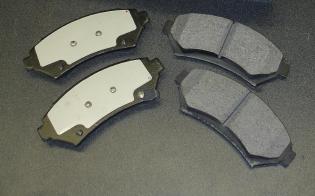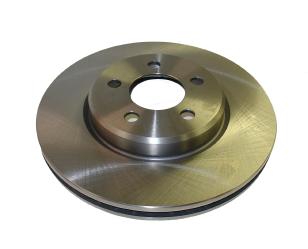
Home, Auto Repair Library, Auto Parts, Accessories, Tools, Manuals & Books, Car BLOG, Links, Index
Basics of Disc Brakes
by Larry Carley copyright AA1Car.com


Disc brakes began to replace the front drum brakes on domestic vehicles in the late 1960s. Unlike drum brakes that push a pair of shoes outward against the inside of a drum to create friction, disc brakes squeeze a pair of friction pads against a flat rotor (disc) to apply the brakes. When the brakes are released, distortion in the caliper piston seals retracts the pistons slightly allowing rotor runout to kick the pads back away from the rotor unlike drum brakes that use return springs to pull the shoes back away from the drum.
In the 1970s, most cars and light trucks were available with front disc brakes as either an option or standard equipment, and by the 1980s disc brakes were standard equipment on all cars and light trucks. Most vehicles retained drum brakes in the rear and still do today, but for the past several decades more and more vehicles are being equipped with four wheel disc brakes.
Disc brakes provide more stopping power than drum brakes, better cooling and fade resistance. The rotor also cannot trap water like a drum, so there is less risk of brake fade when driving during wet weather.

These are the friction linings used with disc brake systems. The friction materials used on the pads will vary depending on the application. The friction material may be nonasbestos organic (NAO), ceramic, low-metallic or semi-metallic. On some applications, the inner and outer pads may use different friction materials.
The friction material on a brake pad is usually molded to the steel backing plate, but may also use rivets for attachment. Some pads have internal noise dampening shims while others use noise suppression shims on the back of the pad. Slots and chamfers on the pads are also used to control noise.
Brake pads wear out and have to be replaced when their thickness reaches minimum specifications or a wear indicator makes noise. On most vehicles, the front pads wear 2X to 3X faster than the rear pads or linings. But on some newer vehicles with Electronic Brake Proportioning, the rear brakes work harder and may wear as fast or even faster than the front brakes.
CAUTION: If you are replacing the brake pads on your vehicle, as a rule you should replace Same with Same or Better. The new brake pads should be the same (or better) grade of friction material as the original pads. Follow the replacement and upgrade recommendations of your friction supplier. Most recommend replacing NAO pads with NAO, ceramic or semi-metallic pads. Replace ceramic with ceramic or semi-metallic, and replace semi-metallic with semi-metallic only. Replacing original equipment semi-metallic pads with softer
ceramic or NAO pads will likely increase pad wear, and may increase the risk of brake fade under hard use in larger, heavier vehicles or performance vehicles.
Disc brake pads are always replaced in pairs (both fronts or both rears) to maintain even braking.

The calipers are the hydraulic components that squeeze the pads against the rotors. The calipers are mounted over the rotors and are attached to a bracket that bolts to the steering knuckle. Most calipers have one or two pistons, but some have up to four or more. Most calipers are cast iron (though some are aluminum) and have steel or molded phenolic (plastic) pistons.
Most calipers are a "floating" design with the piston(s) on the inside of the caliper only. A floating caliper also has slides or bushings that allow the caliper to move sideways so it can center itself over the rotor when the brakes are applied. When the piston moves out and pushes the inside pad against the inside of the rotor, the caliper slides inward and pulls the outside pad against the outside of the rotor. This clamping action is what applies the brakes.

There are also "fixed" calipers that do not slide. This type of caliper has a rigid mounting and there is no in or outward movement when the brakes are applied. A fixed caliper has pistons on BOTH sides of the rotor. When the brakes are applied, the inside and outside pistons move inward toward the rotor at the same time to squeeze the inner and outer pads against the rotor.
On vehicles that have four wheel disc brakes, the rear calipers may have an internal parking brake mechanism to hold the pads against the rotor. Pulling on the parking brake cable pushes the caliper piston outward to apply and lock the rear brakes. On some applications, a "mini-drum" inside the rear rotors is used for a parking brake.
Common problems with brake calipers include fluid leaks due to worn piston seals, and sticking which may be due to corrosion around he piston or corroded slides or bushings. Uneven pad wear (inner pad worn more than the outer pad) is a common symptom of caliper sticking.
Leaky, sticking or damaged calipers should be rebuilt or replaced. Many brake experts recommend rebuilding or replacing the calipers on high mileage vehicles when the brakes are relined to prevent problems later on, even if the calipers are not yet leaking or causing any other problems.
Replacement calipers should have the same type of piston (steel or phenolic) as the original if only one side is being replaced. Otherwise, the type of piston used in the caliper does not matter unless you have a preference for one or the other. Steel pistons and aluminum pistons are stronger than phenolic pistons but can corrode and stick. Steel and aluminum also conduct heat from the pads to the caliper, which increases the temperature of the brake fluid in the caliper and may increase the risk of fluid boil and brake pedal fade during prolonged hard braking. Phenolic pistons are lighter, will not rust or corrode, and help insulate the caliper from heat. However, there have been some instances where phenolic pistons have absorbed moisture over time, causing them to swell and stick. This should not be an issue with calipers provided by a quality supplier.
Caliper mounting hardware such as pins, bushings and slides should also be inspected for corrosion and wear, and replaced as needed when changing calipers. These parts should also be lubricated with a high temperature brake grease so the caliper can move in and out freely when the brakes are applied and released.
Loaded calipers are sold by many auto parts stores and come complete with new pads and mounting hardware for easy installation.

Disc brake rotors may be vented (cooling fins between the faces) or unvented (typical of rear rotors). Some rotors are directional (left and right are different) and have the cooling fins between the rotor faces oriented differently to optimize airflow. The design of the rotor cooling vanes can also differ depending on the application. Some use different fin patterns and/or number of cooling fins to optimize cooling.
Most rotors are made of cast iron while others use a "composite" design with a stamped steel center hat and cast iron disc. Composite rotors are lighter than cast rotors, but also can be more troublesome because they flex more than solid rotors, making them more sensitive to runout and vibration.
Replacement rotors should be the same type as the original, though less expensive one-piece cast iron rotors are available for many applications that originally use composite rotors. Like pads, rotors should be replaced in pairs to maintain even braking side-to-side.

Rotors must be replaced when worn to minimum service or discard specifications. New rotors are also needed if the rotors are cracked, severely corroded or have hard spots. Resurfacing used rotors can restore flatness and parallelism, and is recommended (though not absolutely necessary) when new pads are installed. On vehicles with "captured" rotors located behind the hub, replacement can be difficult and may require replacing the wheel bearings also. One option here is to take your vehicle to a repair facility that has equipment to resurface your rotors while they are still mounted on the hub. On-car resurfacing usually produces less rotor runout than traditional bench lathe resurfacing. Some vehicle manufacturers recommend on-car resurfacing for this very reason if the rotors need to be turned.
See Disc Brake Repair for more information about repairing disc brakes.
Common disc brake problems include:
Worn Pads & Rotors. Pads and rotors wear as the miles accumulate. Frequent stop-and-go driving in heavy urban traffic or mountain driving is very hard on the brakes and will shorten the life of the pads and rotors. Highway driving with infrequent braking will extend the life of the pads and rotors. When the pads and/or rotors are worn, they need to be replaced with new ones.
Noise When Braking. Disc brake noise is a common problem. A high pitched squeal when braking can occur when pads become glazed or worn. The pads may also be noisy if they are slightly loose in the caliper because the anti-rattle clips are bent, broken or missing, or the insulator shim on the back of a pad is damaged or missing. Some semi-metallic pads tend to be noisy even when brand new, while ceramic and nonasbestos organic (NAO) pads are generally quieter. A metallic scraping sound when braking would most likely indicate pads that are completely worn out. Brake noise should never be ignored. The brakes should be inspected to see if the pads and/or rotors are worn or damaged.
Brake pedal vibration when braking. The cause here is uneven rotor wear. Rotor replacement is usually required to end the shudder.
Low Pedal, Soft Pedal or No Pedal When Braking. These are the result of a problem in the brake hydraulics such as a low brake fluid level or fluid leak, leaky caliper piston seal or leaky master cylinder pistons. The entire brake system needs to be inspected and repaired without delay!
 More Brake Articles:
More Brake Articles: Click Here to See More Carley Automotive Technical Articles
Click Here to See More Carley Automotive Technical Articles